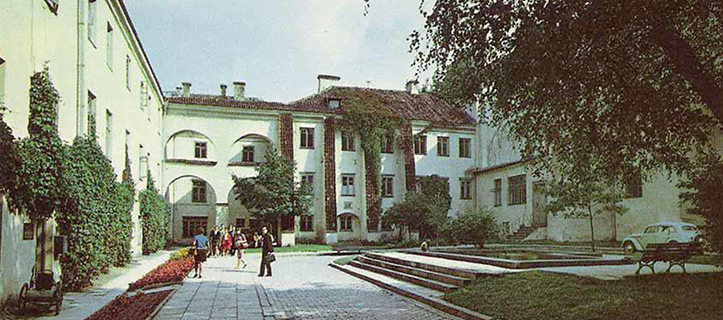
Language studies have been an integral part of Vilnius University’s curriculum since the establishment of Vilnius Jesuit College in 1570. Back then, the primary language taught was Latin alongside Ancient Greek and Hebrew. Thus, even though the Faculty of Philology was established as recently as 1944, language studies were being taught even before the Jesuit College became a university in 1579.
The University’s academics were also interested in the Lithuanian language, which was still considered a colloquial language in the 17thcentury, as official state documents were in Latin, Ruthenian, and Polish. Konstantinas Sirvydas (1579 – 1631), a writer, linguist, and Vilnius University alumnus, wrote “A Dictionary of Three Languages”, the first printed dictionary of Lithuanian. Sirvydas’ work became the foundation of Lithuanian lexicology and linguistics.
In 1803, literary studies gained an increased status as the newly approved Statute of Vilnius Imperial University established four faculties: Physics and Mathematics, Medicine, Moral and Political Sciences, and Literature and Liberal Arts. Courses on rhetoric, poetry, Greek, Latin, Russian, and literature were taught at the latter faculty and were attended by students who later became prominent and internationally renowned Lithuanian scholars and writers, including Simonas Daukantas, Simonas Stanevičius, Adomas Mickevičius among others. In 1817, the faculty’s students also established the then-secret Philomathic Society, which is still active today in its modern iteration.
Despite early instances of linguistic scholarship, proper teaching in Lithuanian studies and philological studies in general only began in the 20th century, when in 1919, one year after the Declaration of Lithuanian Independence, the Faculty of Humanities was established. Jan Otrębski, a professor at the faculty, gave the first lectures on Lithuanian grammar, interpreting Mikalojus Daukša’s “Postilla cathocila”, Lithuanian dialectology, analysing texts in Lithuanian, and the morphology of Baltic languages.
After Vilnius University was closed in 1922, the Faculty of Humanities was relocated to Kaunas State University, where philology courses were taught by Jonas Jablonskis, Mykolas Biržiška, Jonas Tumas-Vaižgantas, Vincas Krėvė-Mickevičius, and Balys Sruoga among others. Twenty years later, in 1939, the Faculty of Humanities returned to Vilnius, with Vincas Mykolaitis-Putinas as the dean. In 1944, the faculty of History and Philology was established, and in 1953, students were first admitted to study the Lithuanian language and literature, and the Russian language and literature. There were also evening studies of English and literature and German and literature.
In 1968, the Faculty of History and Philology was divided into two faculties that still operate today as separate faculties of History and Philology. After the restoration of the independence of Lithuania in 1990, 5 new departments were established: Baltic Studies, Lithuanian Studies, Polish Philology (currently the Centre of Polish Studies), Scandinavian Studies (currently the Centre of Scandinavian Studies), and Translation Studies.
As the courses, professors, and students of Vilnius University changed, so did the University. Throughout time, the University received or acquired many new buildings, some of them built from the ground up and some refurbished from old inns and stables. Many buildings differ in their architectural style, and passageways had to be made between them, yet they still comprise the old central campus of Vilnius University with its 13 unique historical courtyards, the majority of which is occupied by the Faculty of Philology.
Motiejus Kazimieras Sarbievijus Courtyard
Named after the rhetorician and poet Mathias Casimir Sarbievius, the Sarbievius Courtyard is the second biggest courtyard of the old campus of Vilnius University after the Grand Courtyard. In the 16th century, when Vilnius University was still known as Vilnius College, the courtyard was known as the Family Courtyard. The northern buildings of the courtyard, where the Dean’s Office is currently located, used to house a brewery, a carpenter’s workshop, a family bakery, grain barns, and stables. The eastern part served as the living quarters of smiths, shoemakers, tailors, and bookbinders. In the 19th century, these buildings were renovated and repurposed as flats for professors.
The eastern buildings currently house the Departments of Lithuanian Literature, Lithuanian Language, Baltic Studies, and the Kristijonas Donelatis Room. A below-ground passage next to the Donelaitis Room connects the courtyard with the Faculty’s main building, Domus Philologiae and acts as a relaxation zone for students.
A part of the western wing is a restored three-story building, currently the University's library, where in the times of the Jesuit College there was a monk dining hall and other household and college facilities. The southern buildings of the courtyard are probably the oldest, as they still have preserved 17th century structures that echo the time when the buildings were an open stable.
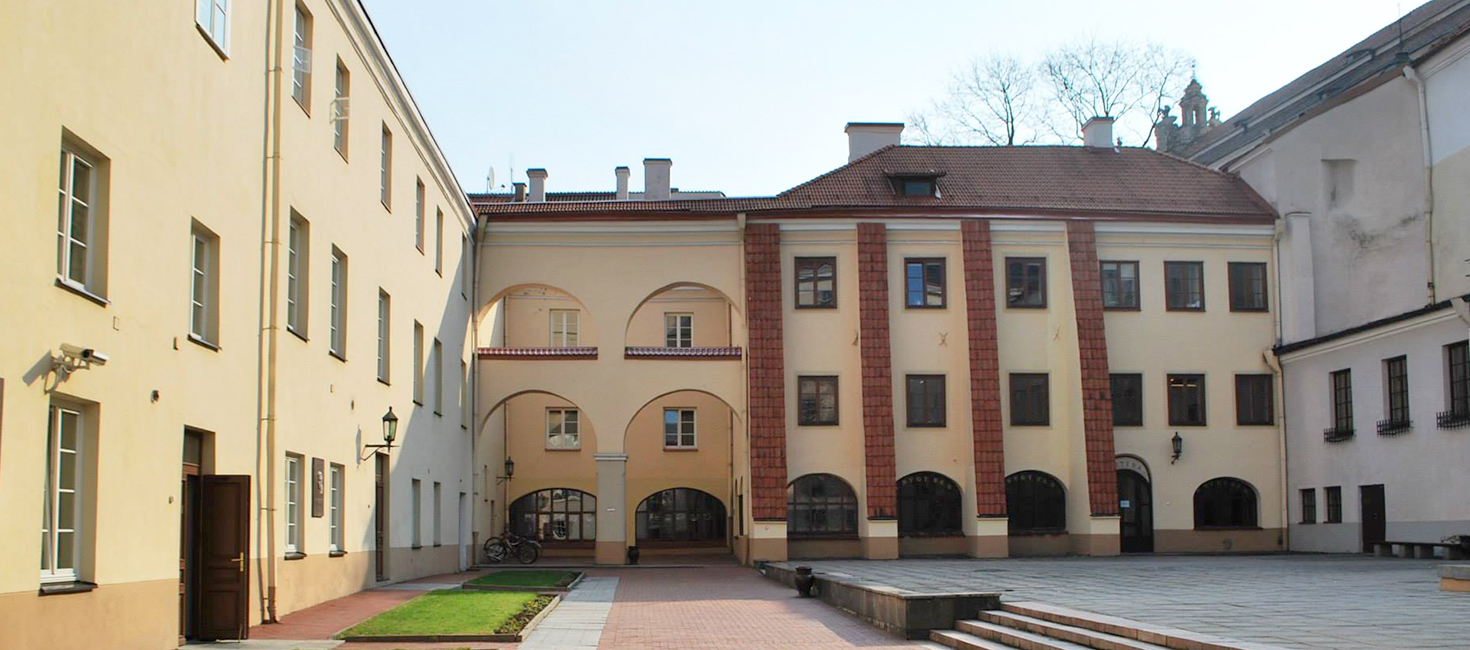
Simonas Daukantas Courtyard
This part of the university campus was built much later than the buildings of Sarbievius Courtyard. It started forming at the end of the 18th century from buildings donated to the University by the members of Vilnius nobility. The building that connects Daukantas and Sarbievius courtyards was built at the juncture of the 16th and 17th centuries and was used for household purposes. This part of the University campus, just as adjacent parts, was used as housing for professors.
The west and east wings were built later. The northern enclosing wall is decorated with a bas-relief of Simonas Daukantas, created by the sculptor Romanas Kazlauskas. The west wing used to house the University’s printing house. A Latin inscription above the entrance to the east building reads Domus Philologiae (Latin for “The House of Philology”). The foyer of the first floor is decorated with a mural by the famous Lithuanian graphic artist Rimtautas Gibavičius. Created in 1969, the Mural depicts the Greek Muses, patrons of the arts. A long hallway leads to another hall with murals celebrating renowned Lithuanian historians, poets, painters, and architects. The foyer next to the Department of Classical Philology is decorated with a mosaic depicting pagan Lithuanian gods. The painter Vitolius Trušys created the mural using fieldstones.
It is told that Simonas Daukantas, the author of the first history of Lithuania written in the Lithuanian language, desired to study at Vilnius University so greatly that he walked to Vilnius all the way from Samogitia (North-western Lithuania). The oak that grows in the middle of the courtyard was planted to commemorate the 400th anniversary of the University’s founding and was collected in the historian’s native Klevų Village. However, the first two oaks planted in the yard did not do well in it, and were replanted in the Konstantinas Sirvydas courtyard located next to the church of St Johns, where they immediately recovered and are still growing to this day. The oak currently growing in Simonas Daukantas Courtyard is thus the third oak to be planted here.
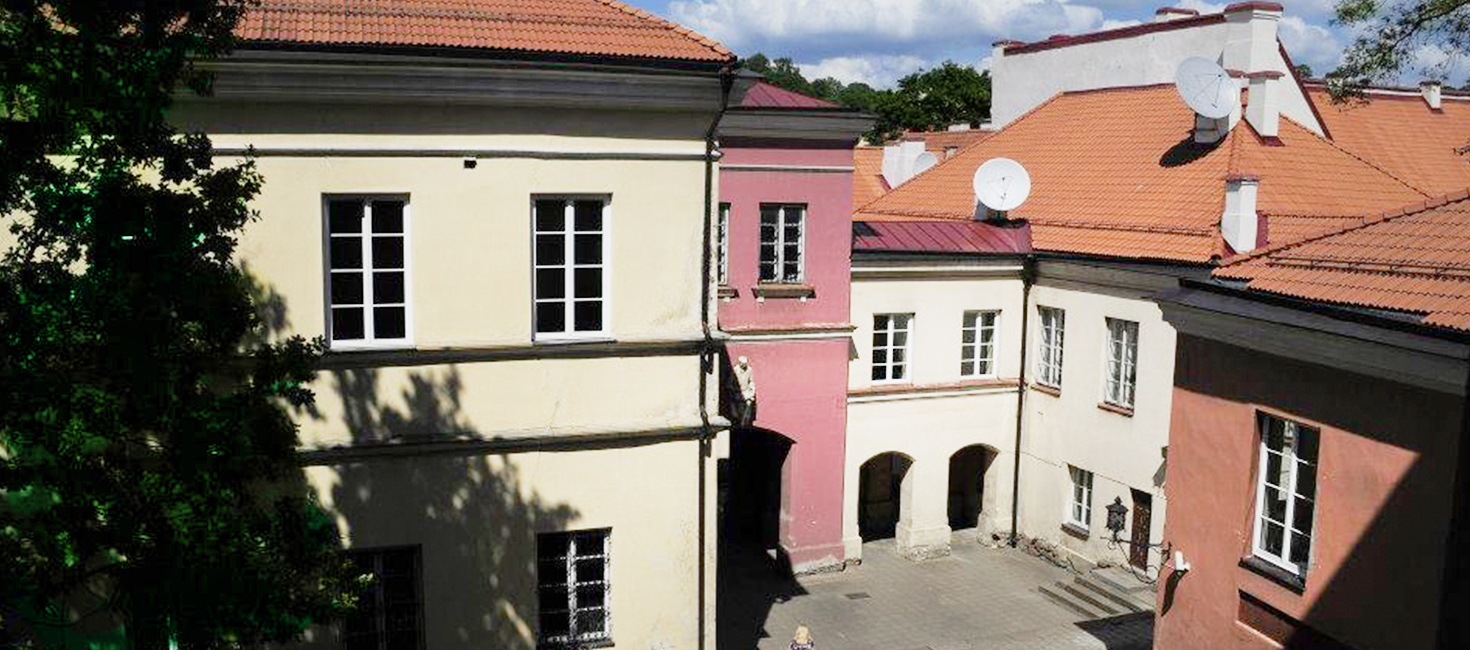
Adom Mickiewicz Courtyard
The current look of Adam Mickiewicz courtyard is the result of reconstructions that were carried out in the second half of the 19th century, when all buildings were joined under a common roof and a western wing was added to the courtyard. The buildings that used to stand in the courtyard belonged to the noble families of Masalskiai, Zavišos, Hevliai, and Ogiński. The eastern wing of the courtyard is the oldest. In the 16th century, there used to be three buildings here. In the second half of the 18th century, they were connected and in 1775, Ignotas Jokūbas Masalskis, the Bishop of Vilnius, donated these buildings to Vilnius University. The buildings were supposed to act as a state dormitory for school students.
In the 18th century, Alexander Ogiński donated the southern wing to the Jesuits and bequeathed it to Vilnius University. When the building was undergoing restoration in 1968, a Gothic façade facing Pilies Street was uncovered and restored. When the University was closed, the eastern wing housed the 2nd Gymnasium of Vilnius City. After WWII, the Museum of Lithuanian History and Ethnography operated in the eastern wing for some time. The south wing was built in the 18th century.
Beginning with 1795, the buildings of Adam Mickiewicz courtyard housed an artillery school of the Vilnius Cadet Corps. The school operated until 1806, when the University received the building. Szymon Malewski, rector of Vilnius University, who lived here until 1832, then occupied the building and the house became known as the Rector House. In 1955, to commemorate the 100th anniversary of Adam Mickiewicz’s death, a memorial plaque was installed on this building from the side of Pilies Street.
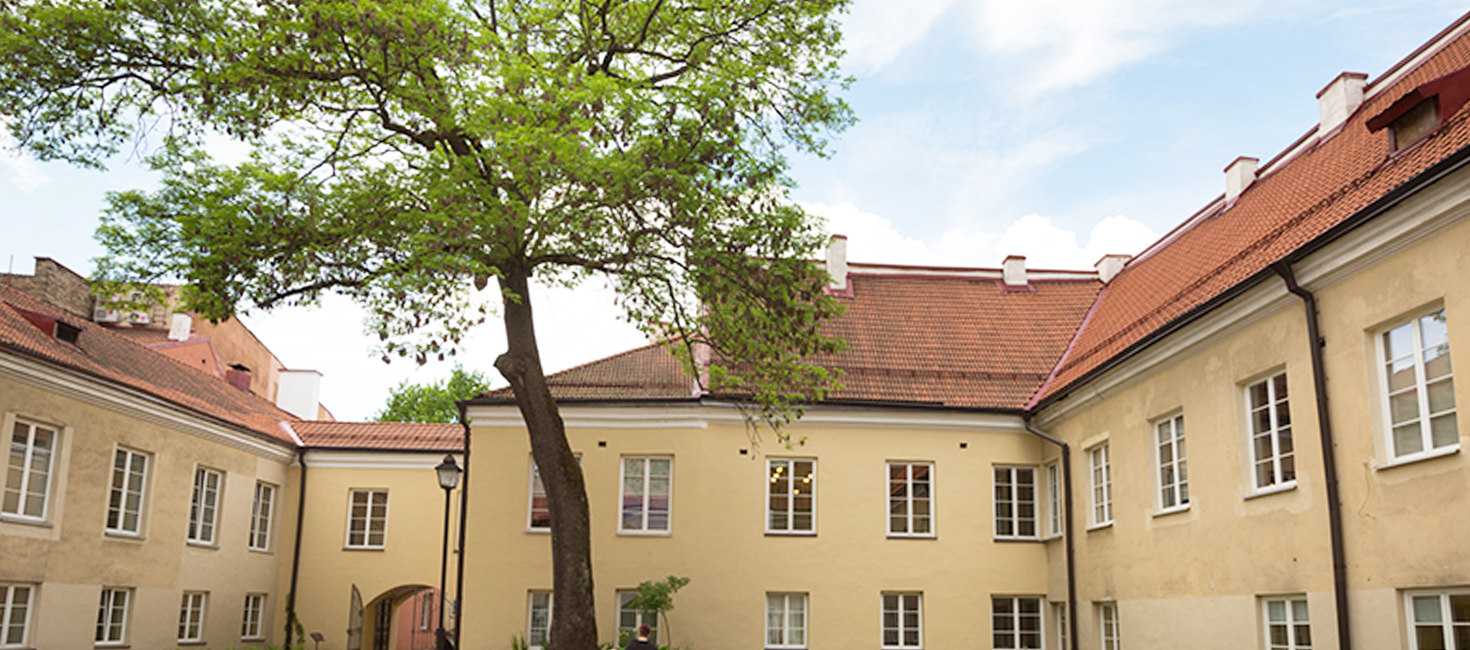
Simonas Stanevičius Courtyard
This courtyard, as the others, is surrounded by several-storied buildings, which used to serve as flats and currently are used as lecture and office space by the Faculty. It is mentioned in archival documents that at the juncture of the 16th and 17th centuries a two-story brick house with a household wing at the end of the yard was built here. The house was sold several times until 1672 when it was bought by the bursary of Ambraziejus Beinartas and became a student residence. The apparently noisy new occupants were unwelcome by their neighbours, who complained of student antics, so in the 18th century, the building was transferred into the property of Vilnius Cathedral, and now was rented only to Vilnius citizens, and not to students. In 1748, the buildings were damaged in a fire, and they were only restored in the 19th century, when a third floor was added and the facades were redecorated. The facades of the courtyard were restored again in 1966 – 1968.
This secluded courtyard is named in honour of Simonas Stanevičius, the University’s alumnus, Lithuanian writer and collector of Lithuanian folk tales.
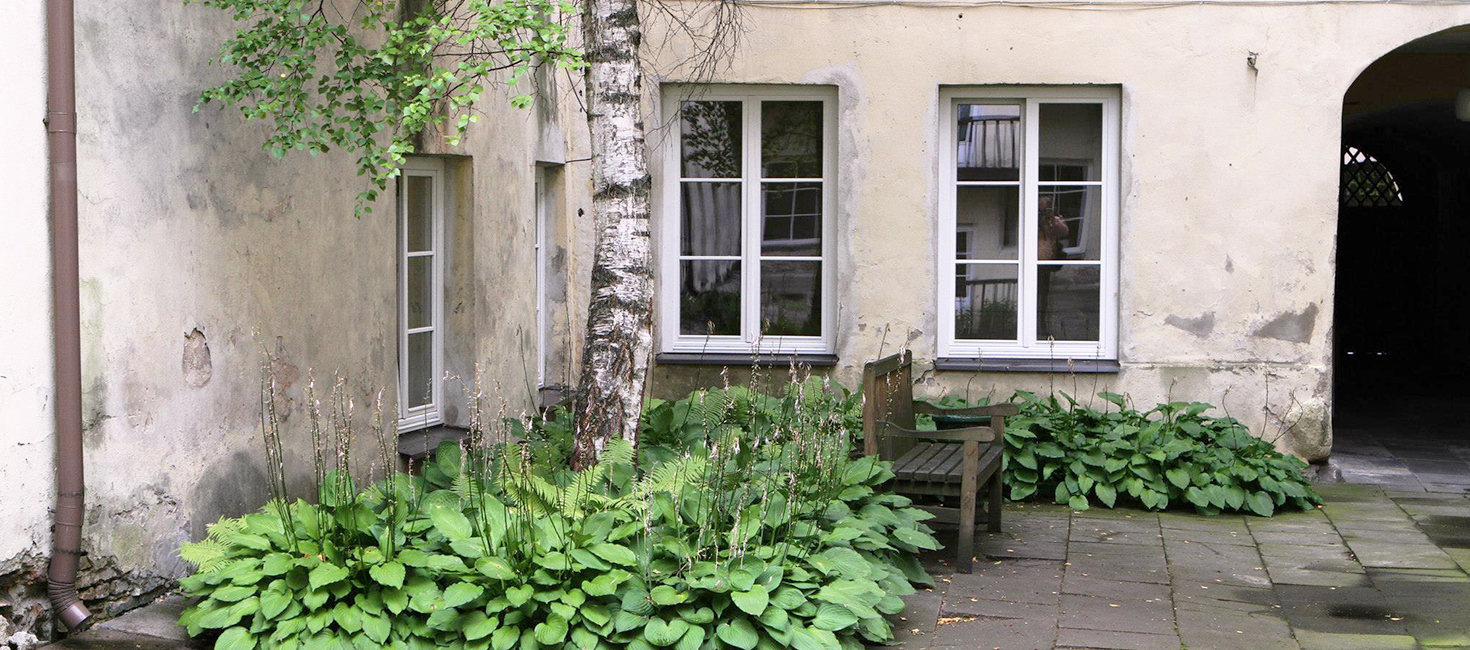
Arkadų Courtyard
In the 17th century, two houses in Skapo Street were connected to form a small courtyard. In the 18th century, these buildings were a property of the noble Korwin-Kosakowsky family, and in 1815 they became the University’s property. In 1832, the buildings of this yard acted as apartments for the teachers of the Second Gymnasium of Vilnius, which was located in the nearby courtyard. In 1873, the buildings of the northern side of Simonas Daukantas Courtyard were joined by a gallery of closed arches. A secluded, cosy space now known as the Arcade Courtyard was thus formed.
The entrance to the Yard from Skapo Street has cylindrical domes with lunettes and load-bearing arches. The main attraction of this court is the metal gates to Skapo Street with ethnographic elements created by the sculptor Juozas Kėdainis.
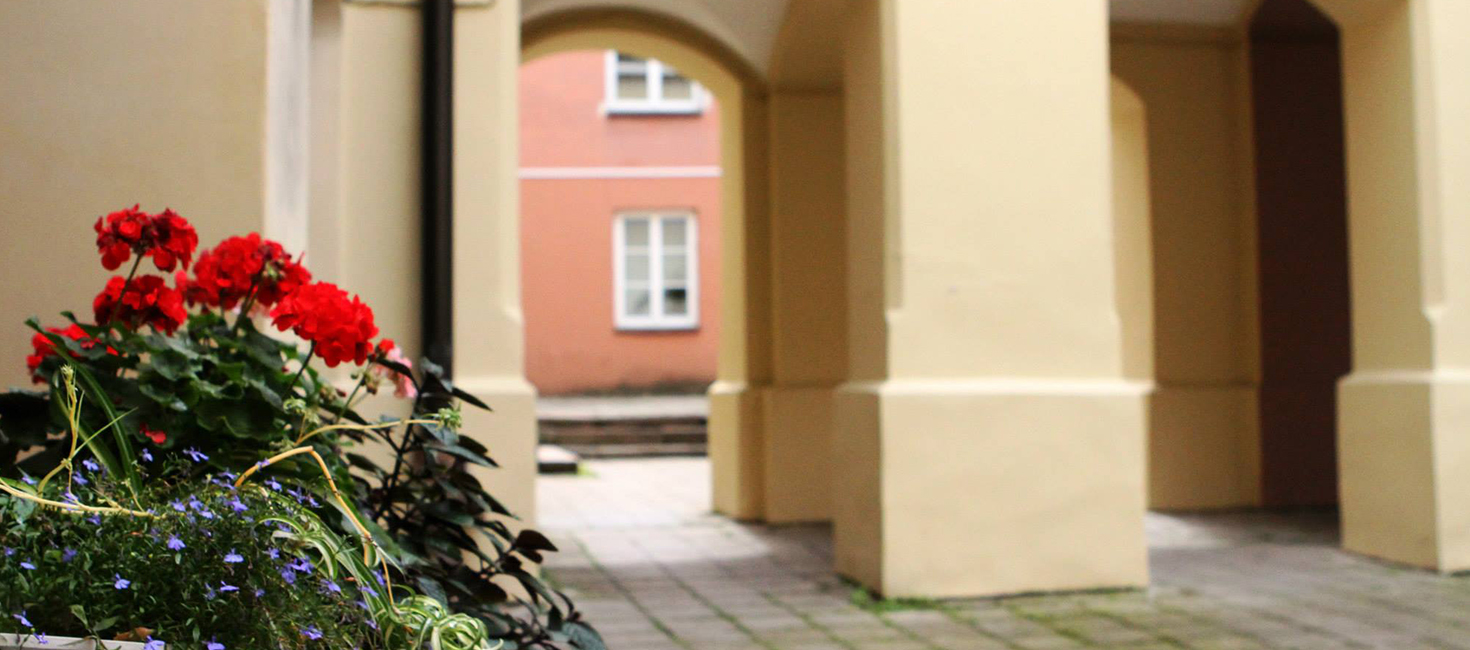
Laurynas Stuoka-Gucevičius Courtyard
For a few centuries, buildings of this courtyard were a property of various noble families. In 1775, the Educational Commission of the Polish-Lithuanian Commonwealth acquired all Jesuit property and bought some additional adjacent buildings. The buildings in the courtyard are of neoclassical and historism periods, with many surviving Gothic elements. The courtyard together with Adam Mickiewicz Courtyard once housed the Artillery Cadet School. Mathematics, topography and fortification-building lectures were taught at this school by the most famous Lithuanian neoclassical architect Laurynas Stuoka-Gucevičius, who designed Vilnius Cathedral and the Old Vilnius City Hall among other buildings.
In 1795, when the Polish-Lithuanian Commonwealth was annexed by the Russian Empire, the buildings of the courtyard housed a Russian cadet corps, which was moved to Hrodna in 1806. The building then functioned as a school, and in 1812–1815 as a hospital. In 1873 after reconstruction a closed courtyard with excellent acoustics was formed. Vilnius Teachers’ Institute occupied the buildings of the courtyard for more than four-decades until 1919. In 1919, the University regained rights to the building, yet after WWII, until 1968 the building functioned as the Museum of Lithuanian History and Ethnography. At one point Gothic cellars were excavated and restored, and were occupied by the University's Chamber Theatre and a student cafeteria. A memorial plaque and a relief of Laurynas Stuoka Gucevičius has been installed on the wall of the northern wing of the courtyard.
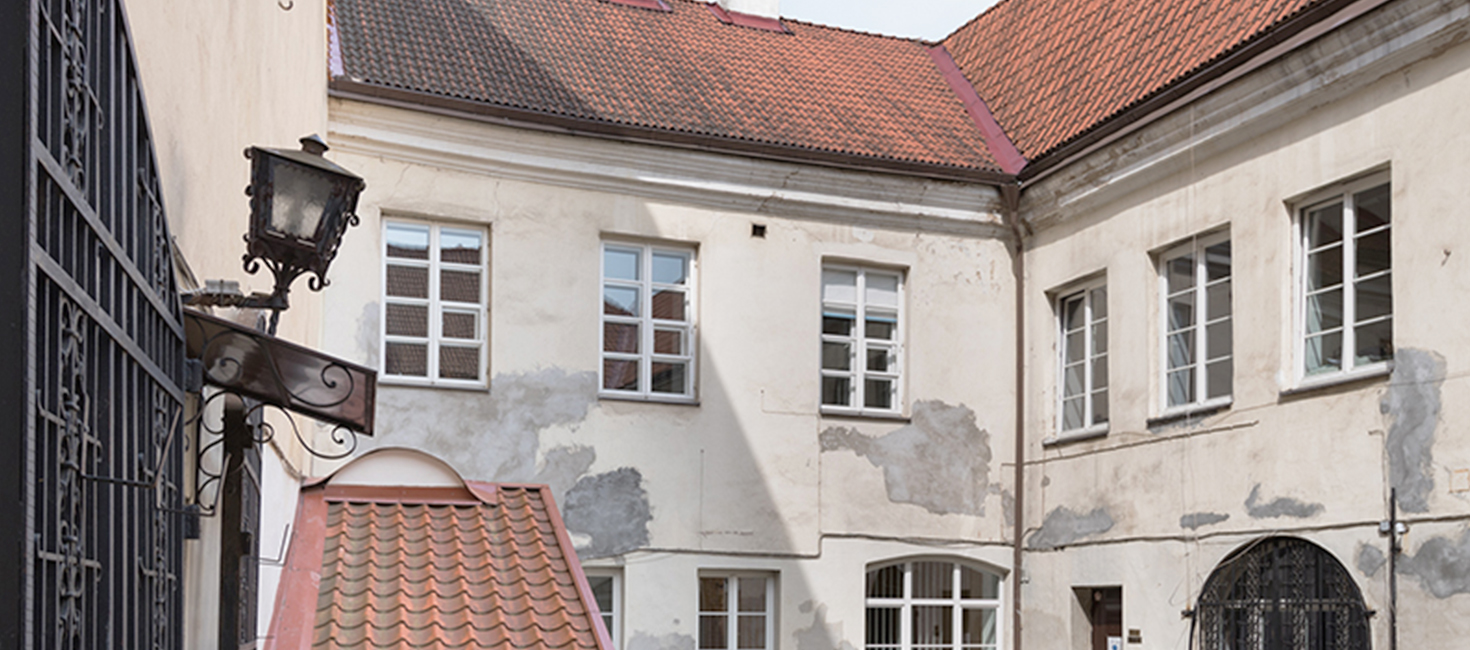
{sliderMaps of the Faculty







